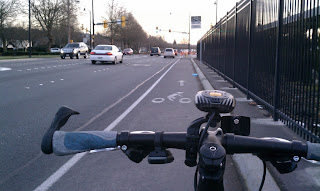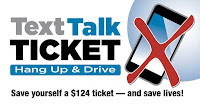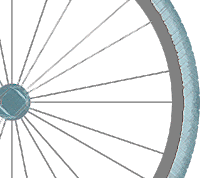Today’s post was submitted by Doug Cantwell, a media professional and bicyclist who lives in Seattle.
Washington’s new distracted driver law took effect in June 2010, making it a primary traffic offense to talk, text or e-mail on a phone or other handheld device while driving. Actively supported by the Bicycle Alliance, passage of this legislation marks a decisive victory for coalition-building through social marketing as a strategy for changing public policy.
“You’ve heard of ‘divide and conquer’ as a way to get results,” said Bicycle Alliance Policy Director Dave Janis, “but it was a ‘unite and conquer’ approach that carried the day in this case. We encouraged agencies and groups that historically didn’t see themselves as sharing common interests to open dialogue with one another and stand together as stakeholders in this legislation.”
This unlikely alliance included public health professionals, insurance industry execs, social marketing gurus, pediatricians, directors of non-profit organizations, prosecuting attorneys, driving school CEOs, law enforcement officers, philanthropy advisors and university professors, among others.
Only two days before Senate Bill 6345 came up for consideration in Olympia last year, the vote was too close to call. But the ‘unlikely alliance’ inundated senators and representatives with last-minute messages of support. At the end of the day, SB6345 had passed by a 2 to 1 margin.
State Patrol: Full Enforcement from Day One
A month before the new law was to take effect on June 10, Washington State Patrol Chief John Batiste announced there would be no ‘educational grace period,’ which is often granted when new legislation requires drivers to change long-standing behavior.
“Drivers have already had nearly two years to adjust their driving habits,” said Batiste, referring to the previous law that had banned phoning and texting but designated them as mere secondary offenses. “We will fully enforce this law from day one.”
The WSP chief expressed disappointment that drivers had shown little voluntary compliance with the old law, that many had in fact demonstrated open defiance. “They would look right at our troopers with phones held to their ears,” he said. “They knew that without another violation we couldn’t do anything.”
Under the secondary-offense designation, troopers wrote only 3,000 citations and issued 5,900 warnings. By comparison, they typically write 300,000 speeding tickets in a given year.
Revenues Support Prevention, Education, Emergency Care
Opponents of the primary-offense law dismiss it as one more attempt to shore up state funding shortfalls during these straitened economic times. To deter police from pulling people over inappropriately, however, the new law stipulates that none of the revenues be allocated to fund law enforcement.
Instead, citation revenues will be divvied up as follows: 36 percent to the local jurisdiction in which the ticket was issued; another 36 percent to the state’s Public Safety and Education account; and the remaining 28% to emergency medical services and trauma care, auto theft protection and traumatic brain-injury awareness.
Primary Enforcement Works
Other critics argue that the primary-offense law only puts the burden on already overextended officers to enforce the unenforceable. But according to the Insurance Institute for Highway Safety, a 2004 primary-offense ban in the District of Columbia reduced handheld phone use by 41 percent; a 2005 Connecticut law produced an immediate decline of 76 percent. The Automobile Club of Southern California saw a similar reduction of 65 percent in that state. Follow-up surveys in all three areas found that long-term declines leveled out at only slightly lower rates, provided that active primary enforcement was maintained.











